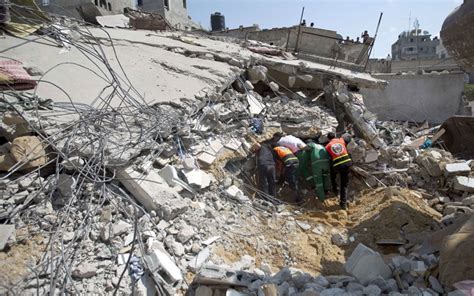On the first day of peace in Gaza, after months of relentless bombings and destruction, the residents and rescue workers were faced with an overwhelming task – to reckon with the sheer scale of devastation that had swept across the region. The images emerging from Gaza painted a grim picture of a land torn apart by conflict, where buildings lay in ruins and streets echoed with sorrow.
**Reckoning with Destruction**
The Gaza Civil Defence agency, serving as the main emergency response unit in the strip, expressed deep concern over the estimated 10,000 bodies believed to be buried under piles of rubble. Mahmoud Basal, a spokesman for the agency, revealed that their efforts to recover the deceased within 100 days were hindered by a severe shortage of bulldozers and essential equipment.
**A Land Devastated**
New visuals captured post-ceasefire displayed scenes of complete devastation, especially in northern Gaza – a stark reminder of the toll taken by 15 months of Israeli offensive. Reports from the United Nations indicated that approximately 60% of structures throughout Gaza had been either damaged or completely destroyed.
As celebrations replaced bomb blasts with hopes for peace on Sunday when the ceasefire came into effect, it became evident that despite temporary calmness prevailing in Gaza, the challenges facing its people were immense. The war had rendered over two million Gazans homeless and entirely reliant on food aid for survival.
**Road to Recovery**
Humanitarian aid began pouring into Gaza immediately following the ceasefire announcement. The UN World Food Programme coordinated efforts to provide essential supplies to those affected by war. However, Sam Rose from Unrwa cautioned that rebuilding Gaza was not just about infrastructure; it entailed healing wounds inflicted by trauma and loss sustained during months of conflict.
“We’re not just talking about food…we’ve got individuals…that need to be rebuilt,”
emphasized Rose. The long road ahead involved addressing not only physical reconstruction but also emotional scars left behind by unprecedented suffering endured by Gazans.
**Returning Home Amidst Ruins**
For displaced Gazans eager to return home amidst uncertainty about what awaited them there stood numerous challenges. Movement remained perilous as Israeli forces initiated withdrawal protocols from populated areas within Gaza while urging civilians to avoid restricted zones established along borders for safety reasons.
Hatem Eliwah’s poignant account shed light on personal tragedies suffered during the conflict – losing family members and yearning for a glimpse of hope amid desolation. The internal turmoil mirrored broader apprehensions regarding sustainability post-ceasefire implementation and fears that fragile peace could shatter at any moment.
**Expert Analysis**
Amidst this backdrop fraught with anguish and uncertainties loomed concerns about sustaining peace agreements between Israel and Palestine. Secretary-General Antonio Guterres emphasized compliance with ceasefire obligations while cautioning against escalating tensions in West Bank due to rising settler attacks exacerbating regional tensions further.
Leading analysts like Muath Al-Khatib highlighted underlying complexities threatening long-term stability in this volatile region ravaged by prolonged conflicts involving global stakeholders vying for influence amidst political impasses surrounding territorial claims and humanitarian crises plaguing innocent lives caught in crossfires.
As humanitarian efforts continued alongside diplomatic dialogues aiming at lasting solutions beyond immediate truces emerged stories displaying resilience amidst despair resonating across global audiences witnessing human spirit striving for hope against odds stacked high yet unwaveringly reaching out for brighter tomorrows even among darkest nights.




Leave feedback about this